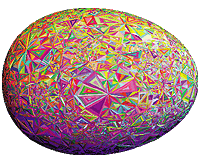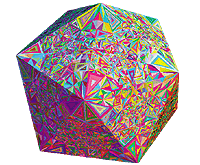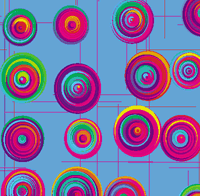From Computer Graphics Toward Computer Art
July 23, 1999
Book Review
Philip J. Davis
The Computer in the Visual Arts. By Anne Morgan Spalter
Addison Wesley, Reading, Massachusetts, 1999.
Graphica 1: The Imaginary Made Real: The Art of Michael Trott. The World of Mathematica Graphics. Wolfram Media, Champaign, Illinois, 1999
Distributed by AK Peters, Natick, Massachusetts.
Graphica 2: The Pattern of Beauty: The Art of Igor Bakshee, The World of Mathematica Graphics. Wolfram Media, Champaign, Illinois, 1999
Distributed by AK Peters, Natick, Massachusetts.
I have watched computer graphics progress from crude pictures of Abe Lincoln typed in x's on an automatic typewriter to the Star Wars stuff. In the late sixties I taught several courses in computer art with punched cards and plug board software. I have noted the progress of the mathematical theory from the Bernstein polynomials of 1913, and the splines of I.J. Schoenberg in 1944, to contemporary NURBS. The rapid development of graphic technology, its refinement, its variety, its complexity, its omnipresence, and its total acceptance amaze me.
Tens of thousands of individuals---perhaps I should say the whole of our computocentric civilization---have brought forth a new craft, a new art both "pure" and "applied," new styles and visual experiences, new mathematics, new aesthetics, and new philosophical problems.
In one volume, Anne Morgan Spalter presents a comprehensive and not too technical statement of where computer graphics now stands. Her book runs the gamut from technology to art, from available software to the psychology of perception, from the history of art to the philosophy of virtual reality, from problems of publication economics to problems of copyright, from feminism to the Web. The topics, particularly the philosophical ones, are often threaded through the whole text, making it not too easy for the reader to arrive at integrated individual statements. Nonetheless, one senses here the force of the exuberant forward march of computer graphics and of its grandiose intentions and impressive potentialities.
The book's lavish illustrations amplify many of these aspects. Included are many pictures in the category of "computer art," with 22 of them in full color on glossy paper, constituting a "Gallery." In addition to references and suggested readings, the author has devised exercises for students.
I'm reminded of Laurence Sterne's Tristram Shandy, whose hero says that it has taken him weeks to write one day of his life. Developments in computer graphics are running ahead faster than any one person's ability to describe or even to know the big picture.
Nonetheless, the author, who is trained in studio art and in computer science, who has exhibited in galleries and who teaches in the Department of Computer Science at Brown University, has written a book to which the reader may turn for encouragement in the pursuit of hands-on experience, or for descriptions of what is available at the click of a mouse keyed to 3-D graphics. It is also a book that invites reveries as to what computer art is now and might become shortly.
As the zealots keep saying, "You ain't seen nuthin' yet. The computer revolution hasn't yet begun." The reader can get a particular foretaste of what is to come on page 15, in the illustration of Benjamin Britton's "Lascaux, 1995," an interactive recreation of the Lascaux Caves, which are now closed off to tourist traffic. Does it follow that the Louvre will shortly be deaccessioning all its treasures and selling wired up T-shirts and virtual reality tracking gloves? Does it follow that the trustees of the Museum of Modern Art and the Whitney will be revving up for buyouts by Disney?
The status of a work of art as an original painting on canvas surrounded by molded hunks of wood has become compromised and is now moot. Art has gone democratic; practically anyone, from aspiring computer Michelangelos to educated ducks, can get into the act, using scanners, antialiasers, frequency-modulated dithering, and create never before seen images of temporarily mind-blowing impact. (I say "temporarily" because as we are saturated---as occurred, for example, with fractal images---the images become absolutely ho-hum.)
Hundreds of instances of (pure) computer art are now available on Web galleries; many of them are for sale. Are these creations crying out for critical review? How many of these pieces will achieve the celebrity of a Rembrandt portrait? Or will the fame of the individual piece be completely overshadowed by the commercial success of specific graphics packages operating at a higher metalevel?
Although I do not underestimate the amount of personal thought and labor involved, Spalter, making use of the word processor and ancillary techniques, has bitten off far more than I am able to chew. In what follows I limit myself to developing briefly two different thoughts engendered by her book.
Short of informational allusions to such concepts as splines, NURBS, transformations, interpolation, there in no mathematics in her book. Here we have a simple reflection of the fact that when mathematics creates successful applications, the mathematics itself goes "underground," embedded in packaging and chipification. The mathematics is then invisible to the wider public. Such invisibility works to the detriment of the mathematical profession.
Our civilization is thoroughly mathematized and is becoming more so with every day that passes, but I doubt that one citizen in a thousand is aware of the vast developments in mathematics that underlie the sweep of plastic along a slot in a supermarket, or that make possible the graphical diagnostics that emerge from a computerized can in a urology lab. To cover in its own terms the mathematics that underlies contemporary computer graphics would by itself require ten books of the length of the one Spalter has written.
I notice that a number of instances of computer art reproduced in Spalter's book are accompanied by explanations of technique, equipment, problems encountered, etc. This is absolutely appropriate. But I also notice in going to gallery shows, either of computer or of traditional art, that the objects displayed are increasingly accompanied by long descriptions (biographical, historical, critical, aesthetic) relating to the objects.
It would seem then that we are in a period when a work of art can no longer stand on its own, but requires paragraphs of text to augment a diminishing or a hardly existing or a totally ambiguous semantic content. As regards computer art, the medium, at the moment, is certainly overwhelming the message.
Graphica 1 and Graphica 2 are twin productions that differ in nature from Spalter's work. They are essentially high-quality "coffee table" books, displaying altogether several hundred examples of computer graphics created by programs in the commercial product Mathematica. The individual images are 7.5 x 7.5 inches; the color and resolution are of eye-shattering brilliance (better than what I get on my Gateway 2000 screen).
Although there is visual overlap, Graphica 1, containing the artwork of Michael Trott, has the more direct and the more complex mathematical basis and appeal. The images employ polyhedra, spirals, 3-D effects, randomness. . . . The images in Graphica 2, the artwork of Igor Bakshee, are planar, simpler, looser, and in many cases are presented as designs for wallpaper, ties, shirts, or decorative tiles.
The authors' artistic intents are strikingly different, reflecting the differences in their current interests. While both Michael Trott and Igor Bakshee are PhDs in physics, the former from the Technical University of Ilmenau, Germany, and the latter from the University of Moscow, and both are on the staff of Wolfram Research, the former concentrates on computer algebra and visualization, while the latter also operates a textile and industrial design firm.


Graphica 1, which displays the work of Michael Trott, also a member of the Wolfram staff, "has the more direct and the more complex mathematical appeal," according to the reviewer. Not visible to readers of SIAM News, of course, are the "color and resolution of eye-shattering brilliance" in both books.
Appendices to both books contain brief programmatic explanations of the images. Graphica 2 employs "Artlandia," a Mathematica-based graphic design package devised by Bakshee. As I turned the pages, my interest in the images varied. When there is either too much or too little visual complexity, my interest diminished. But I don't propose this as a strict principle. On the one hand, there are new grotesque, baroque, or arabesque styles, containing their own computerized varieties of whorls and incrustations, that repel me fully as much as the despised and newly restored Albert Memorial in London. On the other hand, because scale plays a role, I consider the St. Louis arch very simple visually and absolutely breathtaking when viewed on the spot. This observation feeds into the question, discussed by so many over the centuries, from the artist D�rer to the mathematician George David Birkhoff, and here by Trott and Bakshee in their introductions, as to whether aesthetics can be significantly mathematized.


Artwork from Graphica 2, one of a pair of "high-quality coffee table books," produced with Mathematica-based programs. Igor Bakshee, creator of the images shown here, is an employee of Wolfram Research and also operates a textile and industrial design firm.
It is convenient to make a distinction between art and applied art, including in the latter such things as engineering or architectural drawing or commercial art and design. Admittedly, the distinction has a fuzzy edge to it. Shall we call the religious art of the Renaissance applied because it was ordered, executed, paid for, and served to tell a story and inculcate a religious belief? But if the reader grants me the term, I would call the images in the two Graphica galleries, as opposed to those in Spalter's gallery, "applied."
What is clear to me from all three books is that we may indeed have "seen nuthin' yet," and that all previous answers to the age-old question "What is art?" have been made inadequate.
Philip J. Davis, professor emeritus of applied mathematics at Brown University, is an independent writer, scholar, and lecturer. He lives in Providence, Rhode Island.

